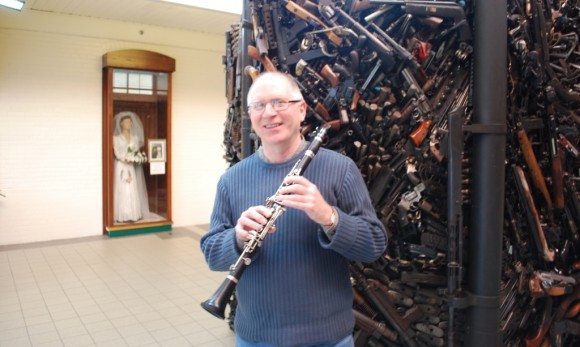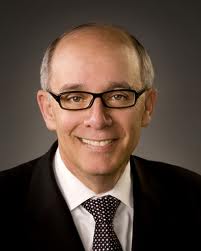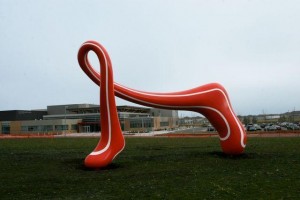EXIT INTERVIEW: Outgoing EAC boss still curious
Posted on May 11, 2013 By Mike Ross Culture, Entertainment, Front Slider, Life, Music, News, Visual Arts
 John Mahon says he’s “probably going to go back to music” after leaving his post as executive director of the Edmonton Arts Council. “That’s where I go when I empty my mind. That’s where I drift.”
John Mahon says he’s “probably going to go back to music” after leaving his post as executive director of the Edmonton Arts Council. “That’s where I go when I empty my mind. That’s where I drift.”
Makes perfect sense. He was a classically trained musician before taking the city’s most high-profile arts administration job in 1998. While overseeing around $13.5 million a year (present day figure) in funding for Edmonton artists, organizations and festivals, Mahon’s music career has effectively been old hold. As an “extra” clarinetist for the Edmonton Symphony Orchestra, he’d play infrequent gigs whose fees he donated back (even if he did have to pay $60 to let his tux out). That’s because EAC gives the ESO an annual grant.
“It’s that perception of conflict of interest,” Mahon says, adding that while he would be perfectly within his rights to get paid to play, “It’s your own standards. I don’t know if it’s because the town’s small or what it is, but you have to have a clean sense of yourself.” Mahon has no say in who gets awarded a grant “or I’d be taken to lunch every day.” That’s the job of arm’s length peer review panels, the EAC itself an arm’s length organization independent from city council. The new EAC boss Paul Moulton explained the big circle nicely in this story.
Being feted with a gala farewell party at City Hall on Monday, May 13, Mahon left no doubt he that his soul is clean in a recent interview in his soon-to-be-vacated office at the Prince of Wales Armoury. Soft spoken and humble, he displays both curiosity and impressive expertise, a potent combination, and makes many connections between the present and the past. He says he stayed on so long – well past the three years his predecessor Josh Keller had recommended – because it “got interesting.” Mayor Bill Smith wasn’t anti-arts; he didn’t think much about the arts at all. Meanwhile, the newly formed EAC had positioned itself around the arts and business community, making headway, “And then Stephen Mandel got elected,” Mahon says. “He’s not just pro arts, he’s all about what this this city as a human network.” Interesting.

The Mayor: Pro arts
Curiosity led Mahon to a career in arts administration to begin with, i.e., what would it be like to produce a show instead of just playing in it? He could talk your ear off about Schubert, but he knows that Corb Lund used to be in a heavy metal band called the Smalls. He can expound at length on any work of public art.
On the question of the distinction between artists and arts supporters, “I’ll use my cliché,” he says. “Mozart was a pretty successful musician. A third of his income was from teaching; but was an impresario. He was trying to promote operas. That’s how he made money. He knew what it cost to rent a hall, what it took to put on a show. So it wasn’t just Mozart writing music. It was him as a complete person, teaching, booking concerts, promotion, production, it’s always been that way. The illusion – I don’t know where it came from – that artists just can be artists and nothing else is a new idea.”
Once upon a time, there was no distinction between artists and craftsmen, between culture and “popular” culture, between art and entertainment. At some point the concept of the artist as a “high priest” of art began to take hold “and you start to see rock stars emerging,” Mahon says. “Art separated into popular art and high art sometime in the 20th century and high art became more and more supported by universities and grants – and some of that stuff, painting, theatre, a lot of music, has no appeal except to very small range of what people might call intellectuals. And it survived because of public support. Meantime, popular art became more sophisticated.”
Which brings us to the crux of the gist of the matter: The value of public funding of art. Mahon likens the difference between “art” and “entertainment” to the difference between science and technology. “Science is a broader, less focused pursuit. It goes everywhere. Occasionally science manifests itself in technology and it makes money. Same thing with art and entertainment.”
And this is why, when the Mayor and the council and the EAC talks about funding the arts, it’s about “investing” in the arts. Mahon, who attended the Royal College of Music in London, and holds an MBA from the University of Alberta, says, “When we invest for the city we figure the city is pretty conservative, but we also know that the city wants some creative risk to be taken. It’s a delicate balance. We don’t just want to be safe, or we’ll just be producing Clint Eastwood movies – which I like, but I’d hate to have to live on them.”
Examples include our old friend Corb Lund, who benefited from various forms of public funding over the years – including Grant MacEwan University. Thanks in part to that, he needs no help now, his recent Mayor’s Arts Award notwithstanding.
 Perhaps the most contentious aspect of the EAC is the “per cent for art” policy, common in many cities. In Edmonton, one per cent of a public construction project’s budget must go towards a work of art to decorate it. Hence the shiny $600,000 Talus Dome that squats at the South end of the Whitemud Bridge. You find these things all over Edmonton.
Perhaps the most contentious aspect of the EAC is the “per cent for art” policy, common in many cities. In Edmonton, one per cent of a public construction project’s budget must go towards a work of art to decorate it. Hence the shiny $600,000 Talus Dome that squats at the South end of the Whitemud Bridge. You find these things all over Edmonton.
The benefit is impossible to measure, Mahon says. It’s clear that a nice sculpture or mural in a certain place makes a that place more pleasant to visit, which may result in preventing litter or broken windows, which may make it more attractive for development and so on and so forth, but try to put a dollar value on it. Mahon asks the public to think of the $80,000 that built the bronze Ezio Faraone statue in the park bearing his name – honouring the Edmonton police officer who was killed in the line of duty in 1990.
Mahon says, “My own girls liked to go look at the nice policeman. So my kids have a pretty positive attitude towards cops now – and how much is that saving the cops? Not that my kids are going to be throwing rocks through windows, but just think about the budget the police might have in reinforcing a positive image and trust and reliability. It would be a big communications budget.” More than 80 grand, is the point.
An unusual thing happens to the public when there’s a new piece of public art, Mahon observes: The more publicity a new installation gets, the bigger the backlash from all corners of the “couldn’t that $600,000 in tax money be better spent than on a pile of shiny balls?” crowd. It seems equally divided between the right and left. Liberals may protest that money spent to build the homeless statue is better spent on the homeless. Conservatives might say money shouldn’t be spent on a homeless statue at all.
Time should heal these complaints, Mahon says, again citing history to support his case: “The Statue of Liberty was vilified when it first presented to the Americans by the French. The Americans had to pay for the base, and it was an awful lot of money after the Civil War. On top of that, it was a woman and it allegorical. And it faces outward. At the time Americans wanted statues of men with beards. The New York Times was saying, ‘why are we spending money on this silly thing?’ One hundred and fifty years later it would be hard to find anyone who doesn’t have a positive attitude about the Statue of Liberty. So, in time.”













